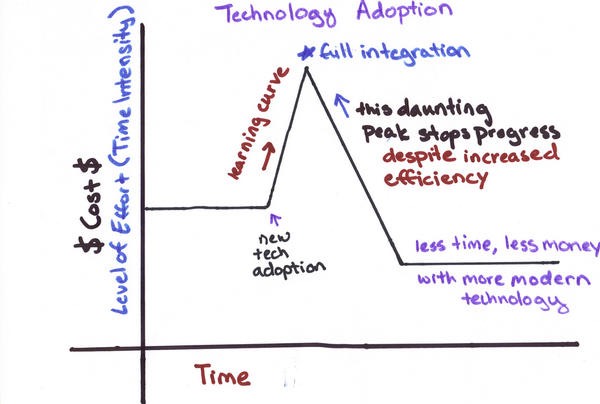
by Karen Newcombe
Some of the best tracking of current business trends go on at Sloan Management Review. This month they have published Embracing Digital Technology: A New Strategic Imperative, a study on what they call "the digital imperative: adopt new technologies or face obsolescence."
What does the Digital Imperative mean for small to medium sized businesses?
Millions of businesses still do not have websites, current era computers, up to date software, or specialized programs to help increase their efficiency. Some have these tools but have no idea how to use them. Many firms that have good websites never update them, don't make use of social media, and don't have any idea how or why clients find their website.
In many cases the learning curve is simply too daunting; the demands of simply running the business day-to-day overrun the time needed to implement new technology. "We already have a website and we dropped our Yellow Pages ad. This saved us thousands of dollars. What more is there?"
Unfortunately, someone among the competition does know how to use their website to its full effectiveness, how to leverage social media to get more clients, and you can be certain they have this year's new computers and great software programs you may not know exist. While you're working hard all day to maintain business as usual, digitally savvy competitors will surpass your business, perhaps even kill it.
Your customers become more digitally oriented every day – and they expect you to keep up.
While you're standing in the aisle at Home Depot checking the reviews on those new refrigerators on your iPhone, some of your clients are doing the same thing for your products or services. What will they find? A four year old website that has never changed? A few snarky reviews on Google from impossible-to-satisfy former clients? Or when prospects search for your service or product, is the first thing that pops up one of your competitor's blog or Facebook page?
Look at how you search for and make decisions about services and products today, and then evaluate your business from that perspective.
What are the benefits to our firm of becoming tech-savvy?
As you can see in the chart above, implementing change in a firm takes time to get over the learning curve, which costs money. But once you achieve full integration, your expended time and cost of operation are lower. You may discover you can offer different products, enhanced or new services, and with greater efficiency you can offer a better experience to your clients. Enhancing customer experience is often the easiest place to start, as you can build on existing relationships as you learn to leverage social media and newer technologies.
What can you do to improve your digital situation?
As the leader of your firm, you need to set a strategic direction – that goes for small businesses, too – and you need to reward movement in that direction. Pick a place to start, for example, pick two goals for the next quarter – update our website and open a Facebook page for our business. Other starting steps include:
- Replace any ratty old computers in your facility, donate them to a school or a non-profit and get current models
- Put someone on your team in charge of finding new software programs that will help automate processes, improve productivity, or simplify something you do all the time
- Bring in that rep from the expensive database program you bought and have them train everyone on staff how to use it. Reward people for learning it and using it effectively.
- Set up a schedule for adding blog entries to your website, and if you don't think you have anything to write about, ask your staff what the top ten questions are that clients ask them about. Start with those.
- Snoop around your competitor's websites, blogs, Facebook pages - what are they doing right? What can you learn from them? What is unique about your firm?
- Call your clients up and ask them, what can we be doing better?
These are small steps, and the road isn't easy.
It is probably easier for a new start-up to leverage current technology than for an established business to create and implement a digital technology strategy. The start-up doesn't need to change existing processes, motivate reluctant people to switch from an ingrained workflow into a new routine, or make the difficult decision to abandon an old software program that everyone is accustomed to using.
But that new start-up will be shinier, fresher, faster, more responsive, and that's where customers will head, so your firm is faced with the choice of changing or dying.
Need help? Call me.
And here's the pitch: I can help you create a strategy, figure out what steps to take, when to take them, I can help with implementation, and I even have colleagues who can help coach your team through the tough parts of undergoing organizational change.
If you are concerned that your firm is behind, call me and let's talk about what you can do within your budget.
In the meantime, visit the MIT Sloan Management website to download their report on Embracing Digital Technology.
Photo credit: Backdoor Survival / Foter / CC BY-NC

